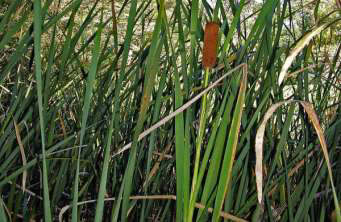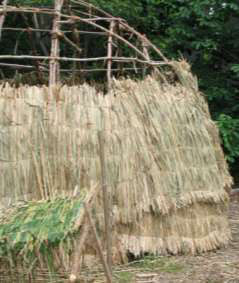 Broadleaf Cattail
Broadleaf Cattail
(Typha latifolia L.)
|
Classification |
| Kingdom: |
Plantae |
| Division: |
Magnoliophyta |
| Class: |
Liliopsida |
| Order: |
Poales |
| Family: |
Typhaceae |
| Genus: |
Typha |
| Species: |
latifolia |
Characteristics: The broadleaf cattail is typically 1 to 7 meters tall, with spongy, strap-like leaves and starchy, creeping stems. The leaves are alternate and mostly basal to a simple, jointless stem that bears the flowers at the top. The rhizomes spread horizontally beneath the surface of muddy ground to start new upright growth. The male flower spike develops at the top of the vertical stem, above the female flower spike. The male flowers are reduced to a pair of stamens and hairs and wither once the pollen is shed, leaving a short, and bare stem portion above the female inflorescence. The dense cluster of female flowers forms a cylindrical spike 10 to as much as 40 centimeters long and 1 to 4 centimeters wide. Broad leaf cattails are monoecious, wind-pollinated, and bear unisexual flowers developing in dense, complex spikes. The seeds are attached to a thin hair or stalk, which aids in wind dispersal.
Habitat: It grows in marshy areas.
Range: Broadleaf cattails grow in temperate, subtropical, and tropical areas throughout the Northern Hemisphere.
 Native American Uses: The broadleaf cattail was used by the Native Americans for many purposes. Medicinally, parts of the cattail were used as dermatological, gastrointestinal, kidney, pulmonary, and venereal aids. It was also used as a disinfectant, for burn dressings, as an emetic, and as an antidiarrheal. The rhizomes are a nutritious and energy-rich food source, generally harvested from late fall to early spring. In late spring, the bases of the leaves, while they are young and tender, can be eaten raw or cooked. The downy material was used by Native Americans as tinder for starting fires. They also used cattail down to line moccasins and papoose boards. The reeds of the cattails were woven together and used as coverings for their shelters. Groups that utilized this species include the Iroquois and the Delaware Indians.
Native American Uses: The broadleaf cattail was used by the Native Americans for many purposes. Medicinally, parts of the cattail were used as dermatological, gastrointestinal, kidney, pulmonary, and venereal aids. It was also used as a disinfectant, for burn dressings, as an emetic, and as an antidiarrheal. The rhizomes are a nutritious and energy-rich food source, generally harvested from late fall to early spring. In late spring, the bases of the leaves, while they are young and tender, can be eaten raw or cooked. The downy material was used by Native Americans as tinder for starting fires. They also used cattail down to line moccasins and papoose boards. The reeds of the cattails were woven together and used as coverings for their shelters. Groups that utilized this species include the Iroquois and the Delaware Indians.
Colonial Uses: The cattail down mixed with pig grease was applied to burns. The down was also collected to make mattresses.